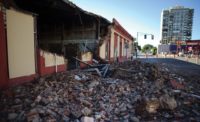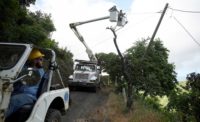More than a week after being rocked by a Jan. 7 earthquake that knocked out its largest power plant, the island of Puerto Rico is still contending with ongoing temblors that are disrupting recovery efforts. The series of continuing earthquakes, which the U.S. Geological Survey anticipates could last another month, is also unsettling daily life. Some citizens have been forced to take refuge in emergency shelters.
Among the biggest infrastructure casualties was the 990-MW Costa Sur power plant in Guayanilla, located in the southern region of Puerto Rico, near the earthquake’s epicenter. According to published reports, officials with the Puerto Rico Electric Power Authority (PREPA) claim that the plant could be down for up to a year.
With Costa Sur out of commission, the utility and authorities turned to re-starting power plants in the northern portion of Puerto Rico that had been shut down for conversions to cleaner burning fuels, says Ricardo Álvarez-Díaz, chairman of architectural firm Álvarez-Díaz & Villalón and a member of the Construction Council of Puerto Rico.
On Jan. 14, PREPA reported via Twitter that electric power service had been restored to 99% of its customers.
On Jan. 7, President Trump signed an emergency declaration that provides aid and empowers the federal government to carry out work. The measure provides an initial $5 million in funds.
In a letter to the president, Gov. Wanda Vázquez Garced stated: “The magnitude of this event is so serious that the state government and the municipal governments of Puerto Rico do not have the capacity to respond effectively.”
As of Jan. 14, “There’s very little that has happened” as a result of federal efforts, says Umberto Donato, president of design-builder DDD Group, and president of Puerto Rico’s chapter of the Associated General Contractors. “The local National Guard has been helping with tents and that’s about it,” he says.
Calling the $5 million in funding approved to date “a drop in the bucket,” Donato says AGC is calling for further appropriations to be used for immediate emergency repairs and to address urgent structural work at schools and hospitals, among other needs.
“We’re looking at ways to use emergency funds to work with the rehabilitation of structures that were either damaged or need to be strengthened to comply with more stringent seismic requirements,” he adds.
As of Jan. 13, the U.S. Geological Survey indicated that the most likely scenario of seismic activity was for “aftershocks to continue to decrease in frequency over the next 30 days,” with none likely to reach magnitude 6.0. The USGS recorded more than a dozen earthquakes on Jan. 14 alone, with one registering at a magnitude of 4.6.
With the earthquakes continuing, some people are opting to stay in emergency shelters, many of them set up in public school buildings. However, many of those schools were built before 1987, when Puerto Rico enacted its seismic building codes. Officials fear that people taking refuge there could be at risk if another major quake occurs.
“A lot of the structures were built before 1987, and most of them have not been retrofitted” to the current seismic codes, says Álvarez-Díaz.
On Jan. 14, the publication El Nuevo Día reported on its website that authorities had teams of structural engineers inspecting schools for structural damage in advance of the scheduled restart of classes on Jan. 22.





